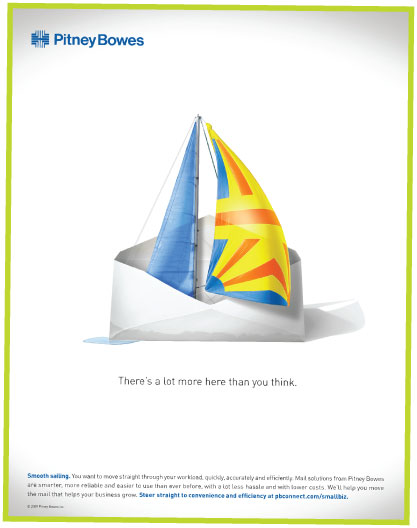 |
BRONZE WINNER: Pitney Bowes Unfortunately, Pitney Bowes' target audience wasn't aware of the extent of the company's capabilities. As a result, it was difficult for Pitney Bowes to communicate its new products and services to potential customers because many ignored any marketing materials from Pitney Bowes because they assumed it applied only to metering mail. Connection Center Microsite: At the heart of the campaign was the Connection Center (www.pbconnect.com), an online resource center that explains the value Pitney Bowes brings to various market segments. The Connection Center is innovative in that it creates a unique experience for each individual segment with relevant information that illustrates how Pitney Bowes' capabilities can be applied to specific business challenges. For example, IT professionals who access the site via online ads or unique URLs included on print ads are welcomed with information specific to Pitney Bowes' technology solutions in the form of white papers, case studies, testimonials and other collateral. The site also features a blog providing industry commentary from Pitney Bowes executives, other business leaders, authors and academia. The blog contains interactive surveys to gauge opinions about important industry topics and a Twitter feed announcing new blog postings and updates on industry events. Advertising Campaign: Creative concepts were developed to gain the attention of those who wouldn't automatically assume a Pitney Bowes message was directed at them. In short, it would make them stop dead in their tracks and look at a banner or print ad that they think doesn't apply to them. This tactic was key to overcoming the “awareness gap” hurdle. Both online and prints ads served as the main vehicle to drive the target audience to the Connection Center site. Worldwide Best Practices: One of the most important aspects of the campaign is that it stayed true to Pitney Bowes' core business and took advantage of the awareness of that core business to promote its new offerings. The campaign also established an Analytics Dashboard concept that can be used in future campaigns to measure campaign effectiveness in real time and adapt specific strategies that are not working as well as anticipated. This approach also ensures future marketing initiatives are fully optimized. Areas measured include “opt-in” features, such as filling out a “contact us” form, subscribing to Pitney Bowes' newsletter, viewing a webinar, subscribing to an RSS feed or clicking on the ShareThis widget. It also measures the average time an individual Results: Early results indicate increased overall awareness of Pitney Bowes' capabilities, strong portal site traffic and higher-than-average banner ad click-through rates. Pitney Bowes plans to conduct a follow-up survey at the conclusion of the campaign—which it will compare to the initial survey conducted prior to the campaign launch—to evaluate the change in perception. |
|
 Client: Pitney Bowes
Client: Pitney Bowes